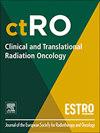复发性肺肿瘤的再照射:剂量与2年生存率的关系
IF 2.7
3区 医学
Q3 ONCOLOGY
引用次数: 0
摘要
背景和目的非小细胞肺癌(NSCLC)患者在接受治疗意向放射治疗(RT) 2年后,高达50%的患者出现局部复发。对于这些患者,根治性再照射(re-RT)是可能的,但缺乏关于疗效和辐射剂量反应的数据,特别是关于常规分步再照射的数据。我们分析了再照射后的生存与放疗剂量之间的关系,以指导临床医生确定再放疗的目标剂量,并预测再治疗的疗效。材料和方法我们对主要由NSCLC患者组成的研究进行了文献检索,这些研究详细说明了2年总生存率(OS2-yr)和给药剂量。这些数据与治疗间隔、PTV大小和使用可获得信息的同期化疗进行了整理。Logistic回归分析os2年与治疗和患者因素之间的相关性。计算了30%和50% os2年所需剂量。结果我们确定了20项合适的研究(675例患者)。在单变量模型中,OS2-yr与初始放疗剂量、再放疗剂量和化疗使用显著相关,但与间隔时间无关。根据赤池信息标准得到的最佳多变量OS2-yr模型仅包含re-RT剂量(p < 0.05),描述数据较好(Hosmer-Lemeshow p值= 0.385)。该模型预测,在2 Gy分数(EQD2s)的49.8 Gy10 (95% CI 36.4, 58.0 Gy10)和76.5 Gy10 (95% CI 70.8, 82.7 Gy10)中,在re-RT等效剂量下,os2年率分别为30%和50%。结论复发性非小细胞肺癌再放疗后的os2年与再治疗剂量显著相关。rert的合理目标剂量为EQD2s >; 50 Gy10,生存率继续增加到85 Gy10。本文章由计算机程序翻译,如有差异,请以英文原文为准。
Re-irradiation of recurrent lung tumours: Associations between dose and 2-year survival
Background and purpose
Loco-regional recurrence is seen in up to 50 % of patients with non-small cell lung cancer (NSCLC) by 2 years after curative intent radiotherapy (RT). For these patients, radical re-irradiation (re-RT) is possible, but data is lacking regarding efficacy and radiation dose response, especially about conventionally fractionated re-irradiation. We analysed associations between survival following re-irradiation and RT dose, to guide clinicians regarding target re-RT dose, and predict re-treatment efficacy.
Material and methods
We performed a literature search for studies primarily comprised of NSCLC patients that detailed 2-year overall survival (OS2-yr) rates and delivered doses. These data were collated with intervals between treatments, PTV sizes and use of concurrent chemotherapy where this information was available. Logistic regression analyses of associations between OS2-yr and treatment and patient factors were carried out. Doses required for 30% and 50% OS2-yr were calculated.
Results
We identified 20 suitable studies (675 patients). In univariable models, OS2-yr was significantly associated with the initial RT dose, re-RT dose and chemotherapy use but not the interval. The best multivariable OS2-yr model according to the Akaike Information Criterion included only the re-RT dose (p < 0.05) and described the data well (Hosmer-Lemeshow p-value = 0.385). This model predicted OS2-yr rates of 30 % and 50 % at re-RT equivalent doses in 2 Gy fractions (EQD2s) of 49.8 Gy10 (95 % CI 36.4, 58.0 Gy10) and 76.5 Gy10 (95 % CI 70.8, 82.7 Gy10) respectively.
Conclusion
OS2-yr following re-RT of recurrent NSCLC is significantly associated with retreatment dose. A reasonable target dose for re-RT is EQD2s > 50 Gy10 with survival rates continuing to increase to 85 Gy10.
求助全文
通过发布文献求助,成功后即可免费获取论文全文。
去求助
来源期刊

Clinical and Translational Radiation Oncology
Medicine-Radiology, Nuclear Medicine and Imaging
CiteScore
5.30
自引率
3.20%
发文量
114
审稿时长
40 days
 求助内容:
求助内容: 应助结果提醒方式:
应助结果提醒方式:


